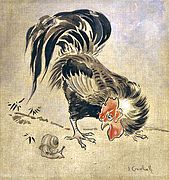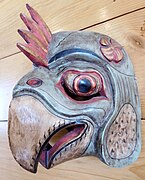Chicken
| Chicken | |
|---|---|
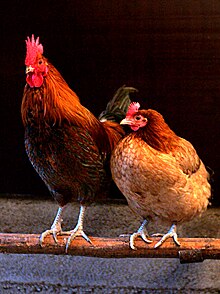
| |
| Male (left) and female chickens | |
Domesticated
| |
| Scientific classification | |
| Domain: | Eukaryota |
| Kingdom: | Animalia |
| Phylum: | Chordata |
| Class: | Aves |
| Order: | Galliformes |
| Family: | Phasianidae |
| Genus: | Gallus |
| Species: | G. g. domesticus
|
| Binomial name | |
| Gallus gallus domesticus | |

| |
| Chicken distribution | |
| Synonyms | |
|
Gallus domesticus | |
The chicken (Gallus gallus domesticus) is a large and round short-winged
Chickens are common and widespread domestic animals, with a total population of 23.7 billion as of 2018[update], and an annual production of more than 50 billion birds. A hen bred for laying can produce over 300 eggs per year. There are numerous cultural references to chickens in folklore, religion, and literature.
Nomenclature
Terms for chickens include:
- Biddy: a chicken, or a newly hatched chicken[1][2]
- neutered male chicken[a]
- Chick: a young chicken[3]
- Chook /tʃʊk/: a chicken (Australia/New Zealand, informal)[4]
- Cock: a fertile adult male chicken[5][6]
- Cockerel: a young male chicken less than a year old[7]
- Hen: an adult female chicken[8]
- Pullet: a young female chicken less than a year old.[9] In the poultry industry, a pullet is a sexually immature chicken less than 22 weeks of age.[10]
- Rooster: a fertile adult male chicken, especially in North America. Originated in the 18th century as a euphemism to avoid the sexual connotation of the British English cock.[11][12][13]
- Yardbird: a chicken (southern United States, dialectal)[14]
Chicken may mean a chick (as in Hen and Chicken Islands).[15] In older sources, and still often in trade and scientific contexts, chickens as a species are described as common fowl or domestic fowl.[16]
Description
Chickens are relatively large
Chickens are omnivores.[20] In the wild, they scratch at the soil to search for seeds, insects, and animals as large as lizards, small snakes,[21] and young mice.[22] A chicken may live for 5–10 years, depending on the breed.[23] The world's oldest known chicken lived for 16 years.[24]
Chickens are
A male's crowing is a loud and sometimes shrill call, serving as a territorial signal to other males,
Reproduction and life-cycle
To initiate courting, some roosters may dance in a circle around or near a hen (a circle dance), often lowering the wing which is closest to the hen.[31] The dance triggers a response in the hen[31] and when she responds to his call, the rooster may mount the hen and proceed with the mating. Mating typically involves a sequence in which the male approaches the female and performs a waltzing display. If the female is unreceptive, she runs off; otherwise, she crouches, and the male mounts, treading with both feet on her back. After copulation the male does a tail-bending display.[32]
Sperm transfer occurs by

Hens often try to lay in nests that already contain eggs and sometimes move eggs from neighbouring nests into their own. A flock thus uses only a few preferred locations, rather than having a different nest for every bird.[35] Under natural conditions, most birds lay only until a clutch is complete; they then incubate all the eggs. This is called "going broody". The hen sits on the nest, fluffing up or pecking defensively if disturbed. She rarely leaves the nest until the eggs have hatched.[36]
Eggs of chickens from the high-altitude region of Tibet have special physiological adaptations that result in a higher hatching rate in low oxygen environments. When eggs are placed in a hypoxic environment, chicken embryos from these populations express much more hemoglobin than embryos from other chicken populations. This hemoglobin has a greater affinity for oxygen, binding oxygen more readily.[37]
Fertile chicken eggs hatch at the end of the incubation period, about 21 days; the chick uses its egg tooth to break out of the shell.[31] Hens remain on the nest for about two days after the first chick hatches; during this time the newly hatched chicks feed by absorbing the internal yolk sac.[38] The hen guards her chicks and brood them to keep them warm. She leads them to food and water and calls them towards food. The chicks imprint on the hen and subsequently follow her continually. She continues to care for them until they are several weeks old.[39]
Origin
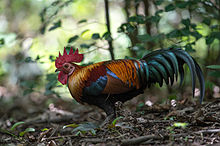
Water or ground-dwelling fowl similar to modern partridges, in the Galliformes, the order of bird that chickens belong to, survived the Cretaceous–Paleogene extinction event that killed all tree-dwelling birds and their dinosaur relatives.[40] Chickens are descended primarily from the red junglefowl (Gallus gallus) and are scientifically classified as the same species.[41] Domesticated chickens freely interbreed with populations of red junglefowl.[41] The domestic chicken has subsequently hybridised with grey junglefowl, Sri Lankan junglefowl and green junglefowl;[42] a gene for yellow skin, for instance, was incorporated into domestic birds from the grey junglefowl (G. sonneratii).[43] It is estimated that chickens share between 71 and 79% of their genome with red junglefowl.[42]
Domestication
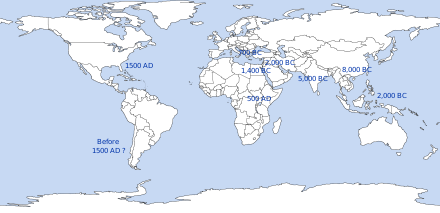
According to one early study, a single domestication event of the red junglefowl in present-day Thailand gave rise to the modern chicken with minor transitions separating the modern breeds.[44] The red junglefowl is well adapted to take advantage of the vast quantities of seed produced during the end of the multi-decade bamboo seeding cycle, to boost its own reproduction.[45] In domesticating the chicken, humans took advantage of the red junglefowl's ability to reproduce prolifically when exposed to a surge in its food supply.[46]
Exactly when and where the chicken was domesticated remains controversial. Genomic studies estimate that the chicken was domesticated 8,000 years ago[42] in Southeast Asia and spread to China and India 2,000 to 3,000 years later. Archaeological evidence supports domestic chickens in Southeast Asia well before 6000 BC, China by 6000 BC and India by 2000 BC.[42][47][48] A landmark 2020 Nature study that fully sequenced 863 chickens across the world suggests that all domestic chickens originate from a single domestication event of red junglefowl whose present-day distribution is predominantly in southwestern China, northern Thailand and Myanmar. These domesticated chickens spread across Southeast and South Asia where they interbred with local wild species of junglefowl, forming genetically and geographically distinct groups. Analysis of the most popular commercial breed shows that the White Leghorn breed possesses a mosaic of divergent ancestries inherited from subspecies of red junglefowl.[49][50][51]
Dispersal
Oceania
A word for the domestic chicken (*manuk) is part of the reconstructed
Americas
The possibility that domestic chickens were in the Americas before Western contact is debated by researchers, but blue-egged chickens, found only in the Americas and Asia, suggest an Asian origin for early American chickens. A lack of data from Thailand, Russia, the Indian subcontinent, Southeast Asia and Sub-Saharan Africa makes it difficult to lay out a clear map of the spread of chickens in these areas; better description and genetic analysis of local breeds threatened by extinction may also help with research into this area.[57] Chicken bones from the Arauco Peninsula in south-central Chile were radiocarbon dated as pre-Columbian, and DNA analysis suggested they were related to prehistoric populations in Polynesia.[58][59] However, further study of the same bones cast doubt on the findings.[60][61]
Eurasia
Chicken remains have been difficult to date, given the small and fragile bird bones; this may account for discrepancies in dates given by different sources. Archaeological evidence is supplemented by mentions in historical texts from the last few centuries BC, and by depictions in prehistoric artworks, such as across Central Asia.[62] Chickens were widespread throughout southern Central Asia by the 4th century BC.[62]
Middle Eastern chicken remains go back to a little earlier than 2000 BC in
Breeding increased under the Roman Empire and reduced in the Middle Ages.[57] Genetic sequencing of chicken bones from archaeological sites in Europe revealed that in the High Middle Ages chickens became less aggressive and began to lay eggs earlier in the breeding season.[66]
Africa
Chickens reached Egypt via the Middle East for purposes of
Diseases

Chickens are susceptible both to parasites such as mites, and to diseases caused by pathogens such as bacteria and viruses. The parasite Dermanyssus gallinae feeds on blood, causing irritation and reducing egg production, and acts as a vector for bacterial diseases such as salmonellosis and spirochaetosis.[67] Viral diseases include avian influenza.[68]
Use by humans
Farming
Chickens are common and widespread domestic animals, with a total population of 23.7 billion as of 2018[update].

Chickens farmed primarily for eggs are called layer hens. The UK alone consumes more than 34 million eggs per day.[78] Hens of some breeds can produce over 300 eggs per year; the highest authenticated rate of egg laying is 371 eggs in 364 days.[79] After 12 months of laying, the commercial hen's egg-laying ability declines to the point where the flock is commercially unviable. Hens, particularly from battery cage systems, are sometimes infirm or have lost a significant amount of their feathers, and their life expectancy has been reduced from around seven years to less than two years.[80] In the UK and Europe, laying hens are then slaughtered and used in processed foods, or sold as 'soup hens'.[80] In some other countries, flocks are sometimes force moulted rather than being slaughtered to re-invigorate egg-laying. This involves complete withdrawal of food (and sometimes water) for 7–14 days[81] or sufficiently long to cause a body weight loss of 25 to 35%,[82] or up to 28 days under experimental conditions.[83] This stimulates the hen to lose her feathers but also re-invigorates egg-production. Some flocks may be force-moulted several times. In 2003, more than 75% of all flocks were moulted in the US.[84]
As pets
Keeping chickens as pets became increasingly popular in the 2000s[85] among urban and suburban residents.[86] Many people obtain chickens for their egg production but often name them and treat them as any other pet like cats or dogs. Chickens provide companionship and have individual personalities. While many do not cuddle much, they will eat from one's hand, jump onto one's lap, respond to and follow their handlers, as well as show affection.[87][88] Chickens are social, inquisitive, intelligent[89] birds, and many people find their behaviour entertaining.[90] Certain breeds, such as silkies and many bantam varieties, are generally docile and are often recommended as good pets around children with disabilities.[91]
Cockfighting
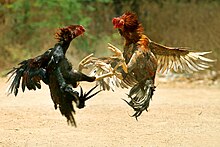
A
In science
Chickens have long been used as model organisms to study developing embryos. Large numbers of embryos can be provided commercially; fertilized eggs can easily be opened and used to observe the developing embryo. Equally important, embryologists can carry out experiments on such embryos, close the egg again and study the effects later in development. For instance, many important discoveries in limb development have been made using chicken embryos, such as the discovery of the apical ectodermal ridge and the zone of polarizing activity.[95]
The chicken was the first bird species to have its
In culture, folklore, and religion
Chickens feature widely in folklore, religion, literature, and popular culture. The chicken is a sacred animal in many cultures and deeply embedded in belief systems and religious practices.[100] Roosters are sometimes used for
-
Etruscan askos in the form of a rooster, 4th century B.C.
-
Rooster and hen, Đông Hồ folk woodcut, Vietnam
-
Feeding the chickens by Walter Osborne, 1885
-
Joseph Crawhall III, Spanish Cock and Snail, c. 1900
-
Wooden chicken mask, Bali, late 20th century
-
Carved and painted wooden tribal statue of a cock fight, Yoruba, West Africa, c. 2000
Notes
- ^ The surgical and chemical castration of chickens is now illegal in some parts of the world.
References
- ^ "Definition of biddy | Dictionary.com". www.dictionary.com. Archived from the original on May 7, 2021. Retrieved May 7, 2021.
- ^ "Biddy definition and meaning | Collins English Dictionary". www.collinsdictionary.com. Archived from the original on May 7, 2021. Retrieved May 7, 2021.
- ^ "Chick". Cambridge Dictionary. Archived from the original on September 7, 2015.
- ^ "Chook". Cambridge Dictionary. Archived from the original on September 7, 2015. Retrieved March 4, 2021.
- ^ "Cock". Cambridge Dictionary. Archived from the original on September 7, 2015. Retrieved March 4, 2021.
- ^ "Hen". Cambridge Dictionary. Archived from the original on September 7, 2015. Retrieved March 4, 2021.
- ^ Cockerel. Dictionary.reference.com. Archived from the original on March 7, 2016. Retrieved August 29, 2010.
- ^ "Hen noun". Merriam-Webster. Retrieved February 2, 2024.
- ^ Pullet. Dictionary.reference.com. Archived from the original on November 9, 2010. Retrieved August 29, 2010.
- ^ "Overview of the Poultry Industry" (PDF). Overview of the Poultry Industry. Missouri Department of Elementary and Secondary Education. p. 8. Archived (PDF) from the original on October 23, 2020.
- ^ "Definition of Rooster". www.merriam-webster.com. Archived from the original on April 22, 2021. Retrieved March 6, 2021.
- ^ Hugh Rawson Archived July 1, 2017, at the Wayback Machine "Why Do We Say...? Rooster", American Heritage, August–September 2006.
- ^ Online Etymology Dictionary Archived November 11, 2020, at the Wayback Machine Entry for rooster (n.), May 2019
- OCLC 12805260.
- ^ "Chicken". Merriam Webster Dictionary. Archived from the original on August 21, 2008. Retrieved March 4, 2021.
- ^ Stevens, Lewis, Genetics and evolution of the domestic fowl, p 1 and throughout, 1991, Cambridge University Press, google books
- ^ a b "Chicken". Smithsonian's National Zoo & Conservation Biology Institute. Retrieved February 2, 2024.
- ^ Geggel, Laura (December 8, 2016). "Forget About the Road. Why Are Chickens So Bad at Flying?". Live Science. Retrieved February 3, 2024.
- .
- ^ "Info on Chicken Care". Ideas-4-pets.co.uk. 2003. Archived from the original on June 25, 2015. Retrieved August 13, 2008.
- ^ D Lines (July 27, 2013). "Chicken Kills Rattlesnake". YouTube. Archived from the original on December 11, 2021. Retrieved March 13, 2019.
- ^ Gerard P.Worrell AKA "Farmer Jerry". "Frequently asked questions about chickens & eggs". Gworrell.freeyellow.com. Archived from the original on September 16, 2008. Retrieved August 13, 2008.
- ^ "The Poultry Guide – A to Z and FAQs". Ruleworks.co.uk. Archived from the original on November 28, 2010. Retrieved August 29, 2010.
- Tuscaloosa News. Alabama, USA. Archivedfrom the original on February 20, 2019. Retrieved May 18, 2020.
- JSTOR 453561.
- ^ Schjelderup-Ebbe, T. (1975). "Contributions to the social psychology of the domestic chicken [Schleidt M., Schleidt, W. M., translators]". In Schein, M. W. (ed.). Social Hierarchy and Dominance. Benchmark Papers in Animal Behavior. Vol. 3. Stroudsburg, Pennsylvania: Dowden, Hutchinson and Ross. pp. 35–49. (Reprinted from Zeitschrift für Psychologie, 1922, 88:225-252.)
- S2CID 141664966.
- ^ AFP (March 12, 2019). "Chickens 'teamed up to kill fox' at Brittany farming school". Theguardian.com. Archived from the original on March 13, 2019. Retrieved March 13, 2019.
- ^ "Top cock: Roosters crow in pecking order". Phys.org. Archived from the original on January 15, 2018. Retrieved January 14, 2018.
- S2CID 53165305.
- ^ ISBN 978-0-7432-4769-6.
- JSTOR 1368360.
- JSTOR 3677097.
- S2CID 17842329.
- .
- ^ "Why Do Chickens Puff up Their Feathers? I 4 Reasons Explained". August 8, 2020. Archived from the original on June 18, 2021. Retrieved June 16, 2021.
- PMID 18809874.
- PMID 4001066.
- PMID 26742081.
- .
- ^ PMID 15592405.
- ^ PMID 32050971.
- PMID 18454198.
- PMID 7809067
- ^ King, Rick (February 24, 2009), "Rat Attack", Nova and National Geographic Television, archived from the original on August 23, 2017, retrieved August 25, 2017
- ^ King, Rick (February 1, 2009), "Plant vs. Predator", NOVA, archived from the original on August 21, 2017, retrieved August 25, 2017
- .
- S2CID 86734013.
- S2CID 220050312.
- PMID 16275023.
- PMID 16458995.
- ^ PMID 24639505.
- ISBN 9781760460945. Archivedfrom the original on November 28, 2022. Retrieved May 5, 2023.
- ISBN 9780521003544. Archivedfrom the original on September 13, 2016. Retrieved March 13, 2019.
- ISBN 9780521546973. Archivedfrom the original on September 13, 2016. Retrieved March 13, 2019 – via Google Books.
- ^ Neumann, Scott (March 18, 2014). "Study: The Chicken Didn't Cross The Pacific To South America". The Two Way. NPR. Archived from the original on May 5, 2023. Retrieved May 5, 2023.
- ^ a b c d e The Cambridge History of Food, 2000, Cambridge University Press, vol.1, pp. 496-499
- S2CID 4418786.
- PMID 17556540.
- PMID 18663216.
- PMID 24639505.
- ^ PMID 38565545.
- PMID 26195775.
- ISBN 9780781811460. Archivedfrom the original on September 13, 2016. Retrieved March 13, 2019 – via Google Books.
- ISBN 9780313334108. Archivedfrom the original on September 13, 2016. Retrieved March 13, 2019 – via Google Books.
- from the original on July 25, 2019. Retrieved July 25, 2019.
- PMID 35057849.
- PMID 31901597.
- ^ "Number of chickens worldwide from 1990 to 2018". Statista. Archived from the original on November 27, 2020. Retrieved February 23, 2020.
- ^ "About chickens". Compassion in World Farming. Archived from the original on April 26, 2017. Retrieved April 25, 2017.
- ^ Fereira, John. "Poultry Slaughter Annual Summary". usda.mannlib.cornell.edu. Archived from the original on April 26, 2017. Retrieved April 25, 2017.
- ^ Fereira, John. "Chickens and Eggs Annual Summary". usda.mannlib.cornell.edu. Archived from the original on April 26, 2017. Retrieved April 25, 2017.
- ^ "Towards Happier Meals In A Globalized World". World Watch Institute. Archived from the original on May 29, 2014. Retrieved May 29, 2014.
- S2CID 154306257.
- S2CID 3016610.
- ^ "Broiler Chickens Fact Sheet". Animals Australia. Archived from the original on July 12, 2010. Retrieved August 29, 2010.
- ^ "Chickens Farmed for Meat". CIWF. Retrieved February 2, 2024.
- ^ "UK Egg Industry Data". Official Egg Info. Archived from the original on December 30, 2016. Retrieved April 25, 2017.
- ISBN 978-0440423102.
- ^ a b Browne, Anthony (March 10, 2002). "Ten weeks to live". The Guardian. London. Archived from the original on May 16, 2008. Retrieved April 28, 2010.
- S2CID 88353703.
- PMID 12817455.
- hdl:11449/14340.
- (PDF) from the original on November 24, 2020. Retrieved October 23, 2020.
- ^ Fly, Colin (July 27, 2007). "Some homeowners find chickens all the rage". Chicago Tribune.[permanent dead link]
- Boston Globe. Archivedfrom the original on March 4, 2016. Retrieved June 4, 2020.
- ^ Kreilkamp, Ivan (November 25, 2020). "How Caring for Backyard Chickens Stretched My Emotional Muscles". The New York Times. Archived from the original on November 25, 2020.
- ^ Boone, Lisa (August 27, 2017). "Chickens will become a beloved pet — just like the family dog". Los Angeles Times. Archived from the original on April 2, 2019. Retrieved April 3, 2019.
- ^ Barras, Colin. "Despite what you might think, chickens are not stupid". www.bbc.com. Archived from the original on June 5, 2021. Retrieved September 6, 2020.
- ^ United Poultry Concerns. "Providing a Good Home for Chickens". Archived from the original on June 5, 2009. Retrieved May 4, 2009.
- ^ "Choosing Your Chickens". Clucks and Chooks. Archived from the original on July 30, 2009.
- ^ Raymond Hernandez (April 11, 1995). "A Blood Sport Gets in the Blood; Fans of Cockfighting Don't Understand Its Outlaw Status". The New York Times. New York City Metropolitan Area. Retrieved May 10, 2014.
- OL 2207173M.
- ^ Lawler, Andrew; Adler, Jerry (June 2012). "How the Chicken Conquered the World". Smithsonian Magazine (June 2012).
- PMID 27840200.
- PMID 15592404.
- S2CID 24237594.
- PMID 27852011.
- ^ Scientists Find Chickens Retain Ancient Ability to Grow Teeth Archived June 20, 2008, at the Wayback Machine Ammu Kannampilly, ABC News, February 27, 2006. Retrieved October 1, 2007.
- ^ Adler, Jerry; Lawler, Andrew (June 2012). "How the Chicken Conquered the World". Smithsonian. Archived from the original on November 3, 2012. Retrieved May 24, 2012.
- ^ Encyclopædia Perthensis; Or Universal Dictionary of the Arts, Sciences, Literature, &c. Intended to Supersede the Use of Other Books of Reference. Vol. 1 (2nd ed.). John Brown. 1816. p. 394.
- Washington Post. August 16, 1981.
- ^ The Knickerbocker, or The New York Monthly, March 1847, p. 283.
- ^ Kellogg, Diane M. (May 22, 2020). "Chickens in Art History". Painting World Magazine. Archived from the original on February 2, 2024. Retrieved February 2, 2024.
- ^ Opie, Iona; Opie, Peter (1997) [1951]. The Oxford Dictionary of Nursery Rhymes (2nd ed.). Oxford University Press. p. 128.
- from the original on January 24, 2023. Retrieved March 23, 2023.
- ^ "AFI|Catalog". Archived from the original on August 17, 2018. Retrieved August 17, 2018.
- ^ "'Chicken' Recipe Simply Divine / Action comedy blends great story, animation". SFGate. June 21, 2000. Archived from the original on June 2, 2021. Retrieved June 2, 2021.
External links
 Data related to Gallus gallus domesticus at Wikispecies
Data related to Gallus gallus domesticus at Wikispecies






